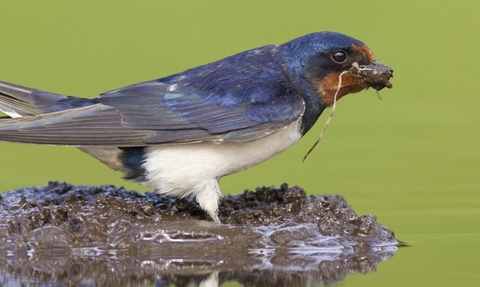
Credit: Mark Hamblin 2020VISION
Staffordshire in Summer
Summer is a time of colour. By day, colourful wildlife zips and darts along the waterside in the form of hunting kingfishers and dragonflies. Butterflies flit between flower and reptiles bask on sun warmed bare earth. The activity carries on under cover of darkness too - bats sweep swiftly through the air and nightjars churr, while glow-worms adorn the night with their luminescent mating rituals.
Welcoming back our migrants and high flyers
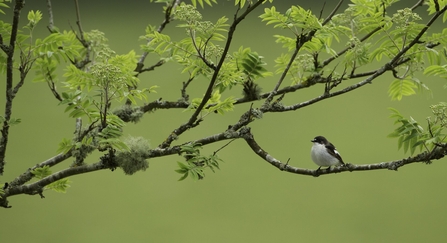
Pied flycatcher by Mark Hamblin/2020VISION
A quick and skilled aerial hunter, pied flycatchers, like the name suggest, will snatch flying insects mid-air, often using the same perch and flying back and forth. These summer visitors thrive in the mild, wet conditions of the UK's temperate rainforests and other suitable woodlands.
As the name suggests, they are black and white, just like our pied wagtails; the female is nearly a mirror image of the male apart from being brown instead of black but sharing the white throat, chest and smaller white feathers on her wings.
They are summer migrants, arriving from Africa to breed in the UK between April and October. Pied flycatchers like our temperate rainforest habitats, which cover less than 1 per cent of Britain and aren't all protected.
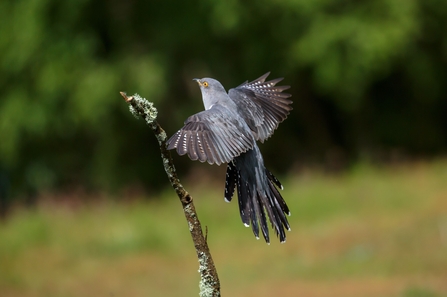
Perhaps the most iconic summer bird sound across the UK is the unmistakable call of cuckoos. Another summer visitor to the UK, their time with us is fleeting due to their nesting habit. They arrive in April and fly back to South Africa by the end of June. They will gather in habitats where there are large numbers of meadow pipits or reed warblers, and can often be seen looking out for prey and unattended nests.
Cuckoos are known brood parasites; which means they do not raise their own young. Instead they lay their eggs in the nests of other birds for them to raise them as their own. The hatched cuckoo will then push out any other eggs or chicks so it gets the sole attention of the mother, continuing to feed even when it is two to three times bigger than the host bird itself.
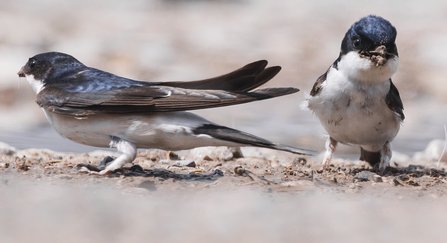
TJELLIS
House martins, although very similar looking to swallows, have dark blue upper parts, a bright white throat and a forked tail. Whereas swallows have much longer tail streamers and a red throat.
Just like swallows they feed on flying insects and aphids which they catch in flight but often feed at a higher altitude. They arrive in April and May and would previously have nested on cliff and rock faces, but the abundance of manmade structures means they are now associated with nesting on houses. They will select sites on top of eaves or under gable ends, earning them their name 'house' martin. They nest in colonies, usually with around five nests at one location.
Despite being associated with houses, they favour open country and farmland with water nearby, where they can often be seen feeding. These high flyers are in decline as their food source of insects is diminishing. They also need wet weather to build their nests earlier in the year and warm weather to gather food, a combination which is not guaranteed due to climate change in the UK anymore.
Mammals in Summer
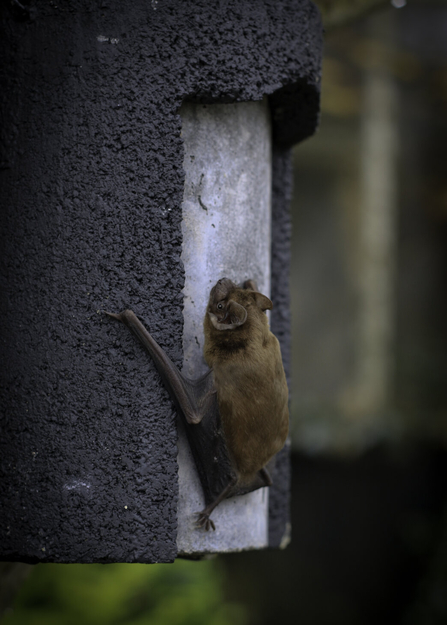
false - Tom Marshall
Often seen flying across tree-tops, the noctule bat is the UK's largest bat. This species relies on tree holes to roost in. They nest in groups and can be heard just before dust, chattering away as they leave the roost to take flight and feed.
They measure 4-5cm in length and weigh up to 40g. Covered in soft golden brown fur, they have a darker brown face and wings, rounded ears and a round nose.
Like our high flying birds, their diet is made up of flying insects, particularly moths. They dive and catch insects from above the tree canopy.
This species is also in decline due to their habitat needs. They require access to mature trees with cavities or old woodpecker nests. Their hunting grounds are much reduced following the introduction of intensive farming methods. While open fields might be okay for hunting, being exposed in the open makes them easy prey for species like hobby's.
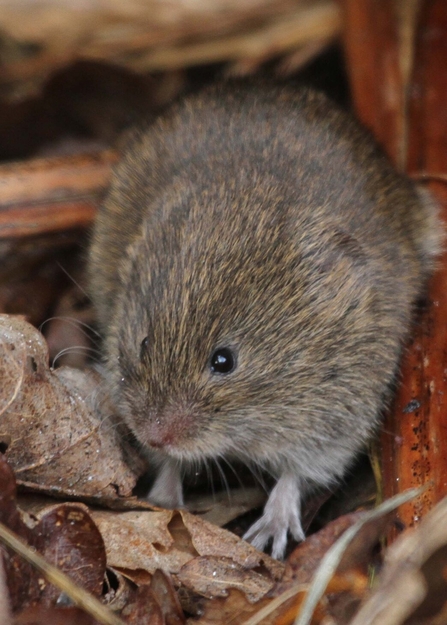
WildNet - Margaret Holland
The sweet secretive field vole is not to be mistaken for bank voles; bank voles have smooth chestnut brown coats and very visible darker-coloured ears. In comparison, field voles have a shaggier grey-brown coat and less visible lighter-coloured ears.
Often seen scurrying across field margins and woodlands with plenty of cover, they can also be seen eating leaves and stems of grasses. Although a species in abundance with an estimated population of 60 million, they are a key prey species for many of our predators such as foxes, stoats, weasels, barn owls, tawny owls, little owls, kestrels and many more! The breeding success of all of these species has an exact correlation to the number of field voles in the local area, a good example of a vital species in the food chain and an important element of a healthy grassland ecosystem.
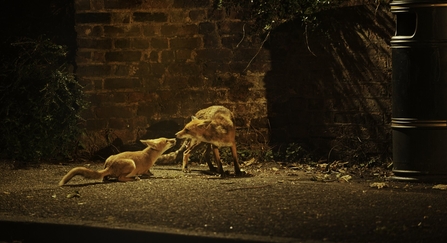
Urban red fox (Vulpes vulpes) adult male and cub on street. West London UK. - Terry Whittaker/2020VISION
Foxes are a UK icon and can be seen across our countryside and our city streets. Like badgers, foxes are opportunistic omnivores, allowing them to survive in a wide range of habitats. Rabbits and field voles are on the menu but they can also eat worms, beetles and fruit. Urban foxes, ever adapting to the decrease of live prey in our cities, will take advantage of any food discarded by people.
During spring foxes would have given birth to a litter of cubs in an underground den. Normally, four or five cubs will be born, and they will be looked after by both the male and female. Throughout summer, we may see cubs taking short trips out of the dens, most likely accompanied by the mother. By autumn, they will be self-sufficient and getting ready to leave and establish their own territories.
It's well know that they share the same habitats and feeding grounds but did you know badgers and foxes can sometimes be seen living alongside each other in badger setts?!
Sun worshippers
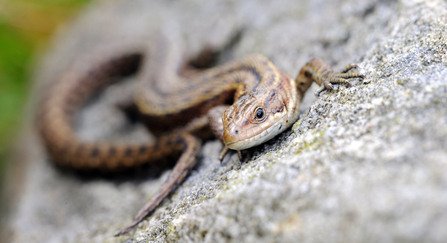
WildNet - Amy Lewis
These timid Common lizards are widespread throughout the UK and are found in grassland, heathland, woodland edges, moorland and sometimes gardens, often bathing in spots of sunshine. On warm, cloudless days, they scan margins, looking for basking places, such as brash piles, low logs and bare rocks. They're hard to spot as they often make sure they're surrounded by cover, so they can make a quick getaway if disturbed or threatened.
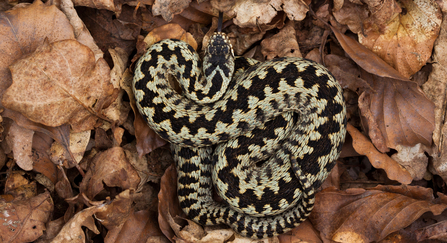
Adder © Jamie Hall
Like our lizard friend above, minus the legs, adders are the only venomous snake in the UK.
Male adders normally have a silvery-grey colouration, while females can be copper or brown. Both have a black zig-zag pattern along their backs. Like the common lizards, they are often seen basking in light patches and close to cover to slither away undetected when needed. They hunt small mammals such as voles and mice, and sometimes lizards. They are also known for eating frogs, newts and small birds, thanks to their venomous to subdue their prey.
Fluttering beauties and dung rollers
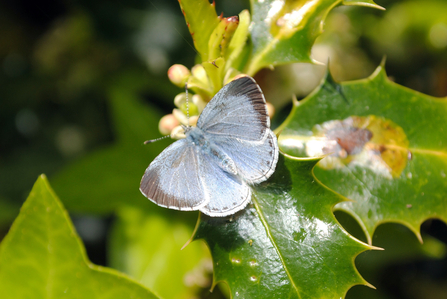
Holly Blue ©Amy Lewis
A delicate blue beauty the holly blue is often seen on its food plant, the holly bush, but can also be seen feeding on juices from rotting fruit or carrion. A small butterfly, it's a light silver blue in colour with black borders to the upper wing and different to species like the small blue, due to black speckles on the underside of its wings. Holly blues can be seen in woods and gardens across England and fluctuate in numbers but are increasingly common.
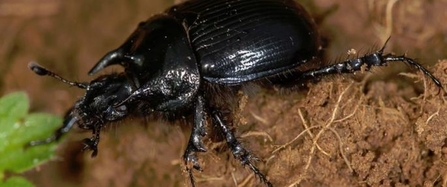
Named for its three bull-like horns, the minotaur beetle is a large dung beetle found on grassland and heathland. Dragging dung back to their nests for their larvae to feed on. These nests can be up to 1.5 metres deep, which is impressive for a species that is no bigger than 2cm! It would fit snugly on the end of your thumb. This time of year, they are more commonly spotted at night gathering dung. By the end of summer in July, the adult's job is done and they die off making way for the next generation.
A hope for our meadows and sweet smells
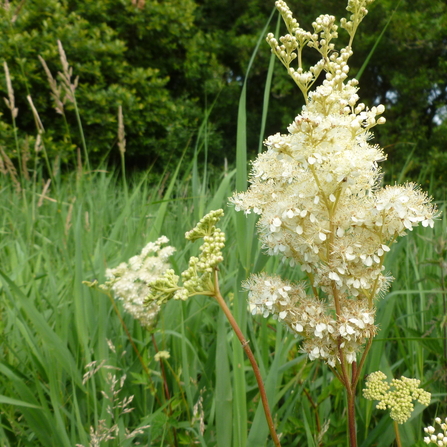
WildNet - Lizzie Wilberforce
Sweet by name, sweet by nature. Meadowsweet displays a 'froth' of creamy-white flowers, densely packed with flower heads on erect stems. Its dark green leaves are divided into pairs of leaflets and have silvery undersides. Not to be confused with cow parsley as it sits around the same height but has a green stem, and all the flowers are on top facing up.
Meadowsweet flourishes in damp soil, often found on riverbanks or meadows. An important food source for several moth species, such as emperor and grey pug moths, many other insects, such as bee flies, are attracted to the flowers.
Did you know?
The flowers of Meadowsweet are sometimes used in wine, beer and vinegar or to give jams a subtle almond flavour. In fact, the common name of this plant likely arose as a result of it being used to flavour mead.
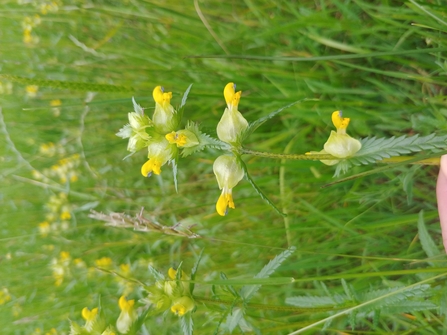
Yellow rattle - Tom Ellis
Yellow rattle has yellow, tube-like flowers protruding from an inflated, green calyx, which appear from May to September. It has serrated leaves with rich, dark veins, which sprout opposite each other all the way up the stem. Its stems have black spots.
When the flowers of yellow rattle fade, the brown calyxes (containing the sepals) in which the tiny seeds ripen can be seen and heard - they give a distinctive 'rattle', hence the common name. Yellow rattle is an annual that thrives in grasslands, living a semi-parasitic life by feeding off the nutrients in the roots of nearby grasses. For this reason, it was once seen as an indicator of poor grassland by farmers, but it is now often used to turn improved grassland back into meadows - feeding off the vigorous grasses eventually allows more delicate, traditional species to push their way through.
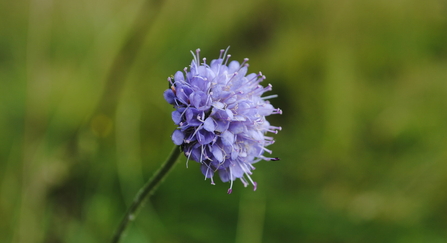
WildNet - Amy Lewis
Devil's-bit scabious has flattened, rounded flower heads that range in colour from blue to pinky-purple. Its leaves are long and oval and differ from those of field scabious, which are dark green, hairy and deeply lobed.
The rounded and nodding, purple-blue flower heads of Devil's-bit scabious can be found in damp meadows and marshes and along woodland rides and riverbanks. It is in bloom between July and October, its pincushion-like flower heads attracting a wide variety of bees and insects. It is also the food plant for the declining Marsh fritillary butterfly, which is classified as a priority species.
Devil's-bit scabious gets its Latin name - 'Scabere', meaning to scratch - from its traditional use as a treatment for skin conditions, such as scabies and the sores of bubonic plague. Its common name arises from the fact that its roots look truncated, as if bitten off, legend has it, by the Devil.








